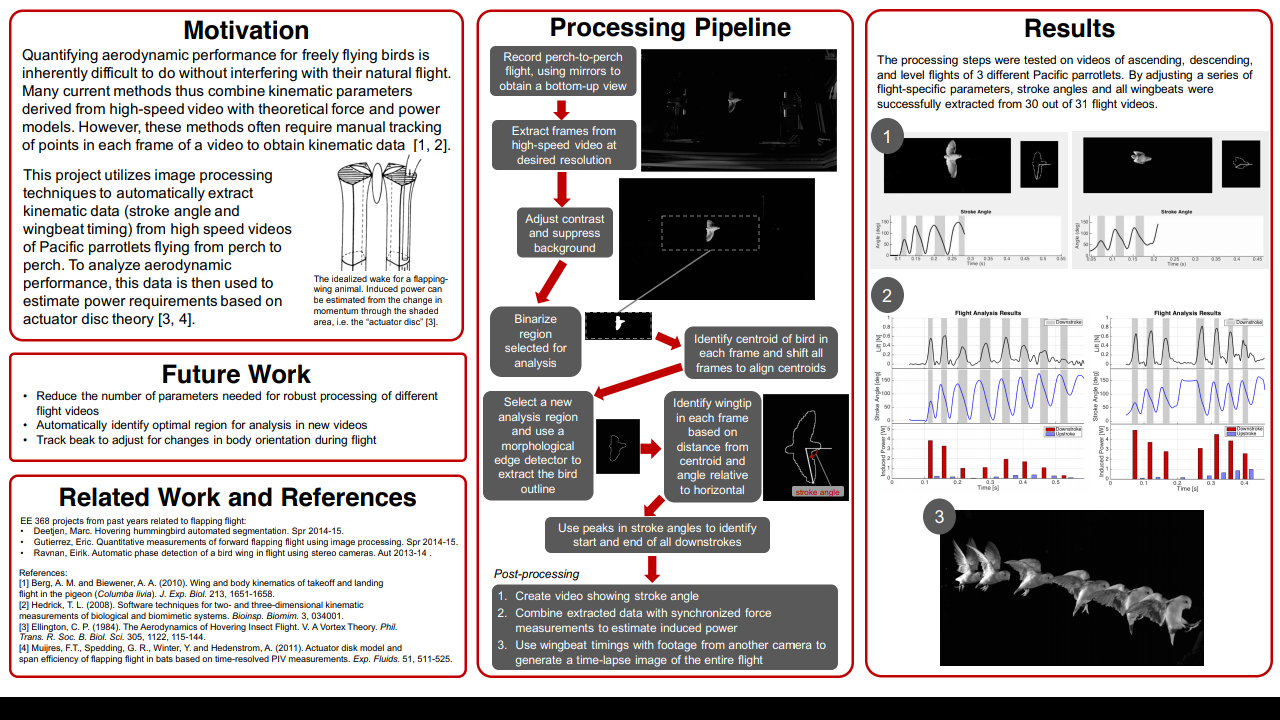aerodynamic performance
✔️ AERODYNAMIC PERFORMANCE DURING FLAPPING FLIGHT
✔️ Background and Motivation
Quantifying the aerodynamic performance of freely flying birds is an open challenge in
the field, because it is inherently difficult to directly measure the forces generated and the
power required by flapping wings without impeding their natural motion. Force estimates are thus frequently derived from kinematic analysis of high speed video. Acquiring this data has traditionally involved tracking markers on the bird, as in [1], using software tools, such as the DLT program described in [2]. Although this program has some automatic tracking capabilities, they only work well with very clearly visible markers and relatively uncluttered backgrounds. However, artificial markers may interfere with the flight of smaller birds. Natural landmarks, such as the eye of the bird, can be used as an alternative, but tracking them often involves manual clicking of points in each frame of a high speed video. This is not only a tedious process, but can also introduce more noise into the resulting kinematic data. Finding a way to reliably automate the acquisition of kinematic data from high speed video is thus highly desirable. Another popular method for evaluating animal flight performance is to estimate power based on models such as the actuated disc theory. Although this theory was originally developed for helicopter blades, it has been used to approximate induced power for hovering insects [3] and forward flying birds [4]. As shown in Fig. 1, the wings are modeled as an actuator disc, similar to a helicopter
rotor, and the induced power is derived from the change in momentum as air passes through this disc into the wake below. The area swept by the wings is a critical parameter in this model, so acquiring it directly from high speed video should yield more accurate
power estimates.
✔️ Goals and Implementation
In my current research, I am studying the perch to perch flight of Pacific parrotlets inside
of an aerodynamic force platform. I am recording flights using a set of high-speed cameras with different views, including a bottom-up view (using mirrors placed on the bottom of my setup, as shown in Fig. 2). For my project, I plan to use digital image processing techniques on these videos to (1) derive time-resolved kinematic data (e.g. velocity, acceleration, and wing-stroke timing), and (2) determine the actuator disc area used by the birds so that I can make force and power estimates. For acquiring the kinematic data, I will first try detecting
the eye or another discerning feature in the videos to derive velocity and acceleration. I will then try an alternative approach, where I will isolate the bird silhouette by adjusting contrast to reduce the effects of non-uniform lighting, and then apply thresholding (and the filling-in of (holes if needed). I will then track the centroid of the silhouette instead of other anatomical features. To determine wing-stroke timing, I will try template matching based on expected wing-shapes of a downstroke or upstroke, and/or I will try to find the timing based on when the distance from the wingtip to the centroid is at a local maximum.
To determine the actuator disc area, I will first process the frames of the bottom-up view
so that the bird remains in the same position across all frames. I will try to do so either using keypoint detection, or by shifting the frames to keep the centroid of the thresholded bird in the same position. I will use the resulting frames to estimate the stroke amplitude of the bird, from which I can calculate a closer approximation of the actuator disc area. Additionally, if time permits, I also hope to try stitching together frames taken during different wing-stroke phases, so that I can show the entire perch to perch flight in one image. I do not plan on using an Android device.
✔️ References:
[1] Berg, A. M. and Biewener, A. A. (2010). Wing and body kinematics of takeoff and landing flight in the pigeon (Columba livia). J. Exp. Biol. 213, 1651-1658.
[2] Hedrick, T. L. (2008). Software techniques for two- and three-dimensional kinematic
measurements of biological and biomimetic systems. Bioinsp. Biomim. 3, 034001.
[3] Ellington, C. P. (1984). The Aerodynamics of Hovering Insect Flight. V. A Vortex Theory. Phil. Trans. R. Soc. B. Biol. Sci. 305, 1122, 115-144.
[4] Muijres, F.T., Spedding, G. R., Winter, Y. and Hedenstrom, A. (2011). Actuator disk model and span efficiency of flapping flight in bats based on time-resolved PIV measurements. ExFluids. 51, 511-525.
✔️ SOURCE CODE CLICK HERE




Thank you for your post. This is useful information.
ReplyDeleteHere we provide our special one's.
phone job training center
iphone training classes in hyderabad
iphone training institute in hyderabad